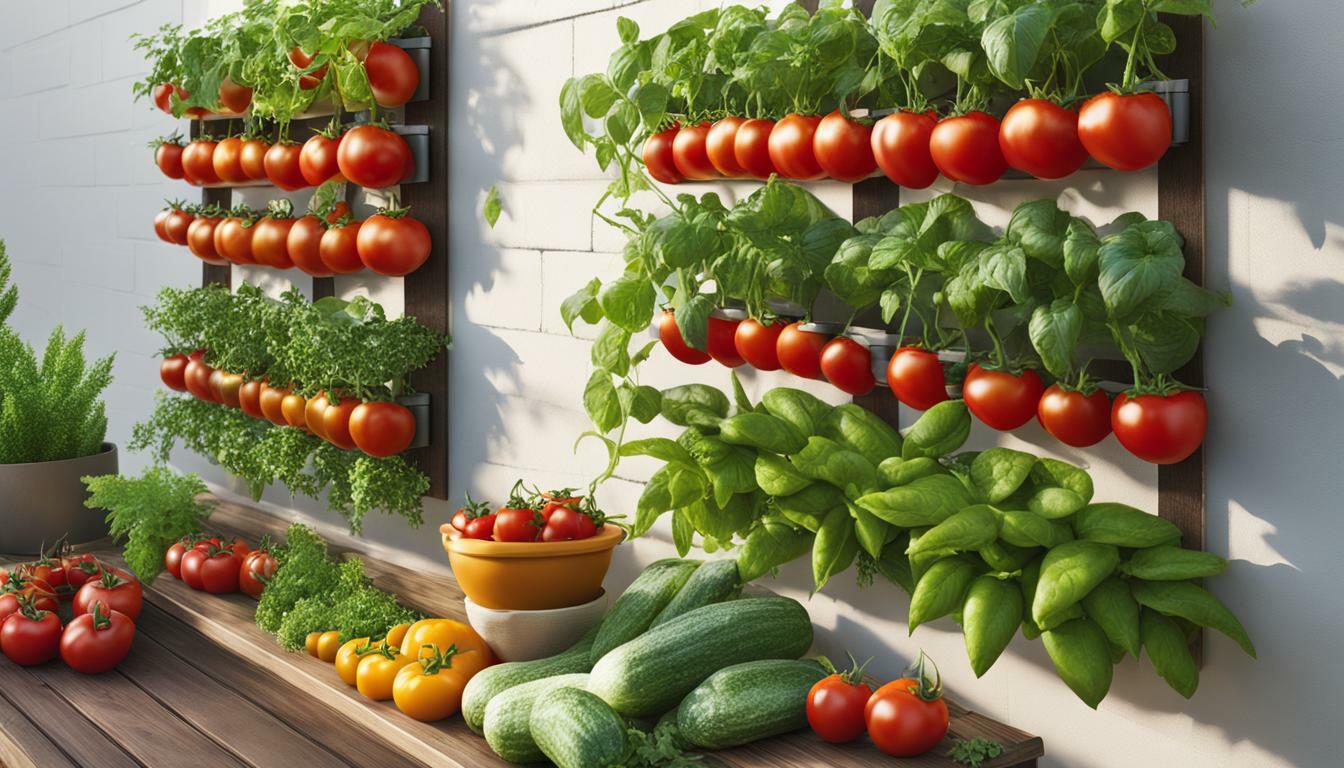Transforming your urban space has never been easier with the help of our comprehensive guide on creating a vertical veggie garden. By harnessing the upward growth potential of plants, you can save space while maximizing your yield of fresh, homegrown vegetables.
Key Takeaways:
- Creating a vertical veggie garden allows you to grow vegetables upward, saving space in your urban environment.
- A vertical veggie garden can maximize the yield of fresh, homegrown vegetables by optimizing sunlight exposure.
- This comprehensive guide will provide you with the knowledge and tools to select the right plants, build a sturdy vertical support structure, optimize soil and nutrients, implement efficient watering systems, and prevent pests and diseases in your vertical veggie garden.
Understanding the Benefits of a Vertical Veggie Garden
Discover the multitude of benefits that come with cultivating a vertical veggie garden in your urban space. Not only does it allow you to grow your own fresh produce, but it also maximizes the use of limited space, saves water, and provides a beautiful green environment right at your doorstep.
One of the key advantages of a vertical veggie garden is its space-saving nature. In urban areas where land is scarce, vertical gardening offers a solution by utilizing vertical space rather than spreading out horizontally. By growing veggies upward, you can make the most of limited balcony, patio, or rooftop space, transforming it into a lush garden that yields abundant crops.
| Benefits | Description |
|---|---|
| 1. Space-saving | Utilizes vertical space in urban areas |
| 2. Maximize yield | Grows multiple plants in a small area |
| 3. Optimize sunlight exposure | Allows plants to receive adequate sunlight |
| 4. Convenience | Easy access to fresh produce |
Vertical gardening also maximizes yield by allowing you to grow multiple plants in a small area. By utilizing vertical structures such as trellises, hanging baskets, or wall-mounted planters, you can grow a variety of vegetables and herbs simultaneously. This not only diversifies your harvest but also optimizes the use of resources, such as water and fertilizers, leading to a more sustainable gardening practice.
Another benefit of vertical veggie gardening is the ability to optimize sunlight exposure. By positioning your plants vertically, you can ensure that each plant receives adequate sunlight, even in shaded or partially shaded areas. This allows for healthier growth, better photosynthesis, and ultimately, higher yields.
Quote:
“Vertical veggie gardening is a game-changer for urban dwellers who want to enjoy the benefits of homegrown produce without compromising their limited space.” – Gardening Expert
In addition to the practical advantages, vertical veggie gardening brings convenience to your life. Imagine having fresh, homegrown vegetables right at your fingertips. No more rushing to the grocery store or worrying about the quality of store-bought produce.
With a vertical veggie garden, you have the freedom to choose the varieties you love, cultivate them organically, and enjoy the satisfaction of harvesting your own food. Whether you’re a seasoned gardener or a beginner, vertical veggie gardening opens up a world of possibilities and rewards.
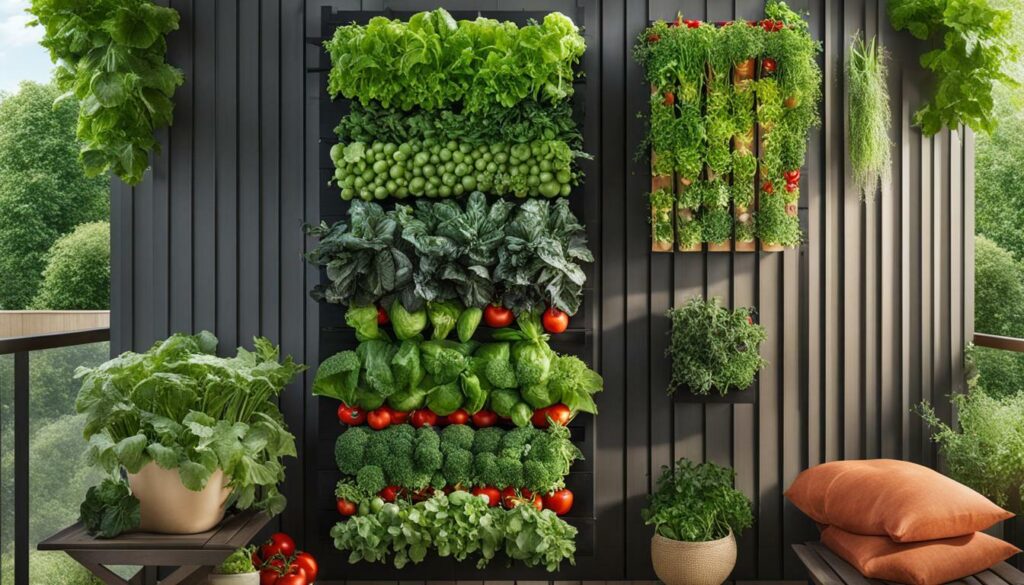
By harnessing the benefits of vertical gardening, you can transform your urban space into a thriving oasis of fresh, nutritious produce. Embrace the potential of vertical veggie gardening and enjoy the bountiful rewards it offers.
Selecting the Right Plants for Your Vertical Veggie Garden
Careful plant selection is crucial for a successful vertical veggie garden – learn how to choose the perfect crops for your unique space.
When it comes to creating a vertical veggie garden, selecting the right plants is essential for maximizing your yield and ensuring optimal growth. Consider the following factors when choosing the crops for your vertical garden:
1. Sunlight Requirements:
Before deciding on the plants for your vertical garden, determine the amount of sunlight your space receives. Some vegetables thrive in full sun, while others prefer partial shade. Evaluating the sunlight conditions will help you choose the suitable crops that will thrive in your vertical garden.
2. Space Constraints:
Vertical gardening allows you to save space, but it’s still important to consider the available area. Some vegetables, such as vine tomatoes or climbing beans, require more vertical space, while others like lettuce or herbs can be grown in smaller containers. Assess your space limitations to select plants that will fit well and thrive in your vertical veggie garden.
3. Growing Conditions:
Take into account the growing conditions in your area, such as climate, temperature, and humidity. Certain plants are better suited for specific regions or seasons. Research the recommended growing conditions for each vegetable to ensure they can thrive in your vertical garden.
Once you have considered these factors, you can choose from a variety of vegetables that are suitable for vertical gardening. Here are some popular options:
| Vegetable | Sunlight Requirements | Space Constraints | Growing Conditions |
|---|---|---|---|
| Tomatoes | Full Sun | Require Vertical Support | Warm Climate |
| Cucumbers | Full Sun | Vertical or Horizontal Space | Warm Climate |
| Lettuce | Partial Shade | Smaller Containers | Cool Climate |
| Herbs (Basil, Thyme, etc.) | Full Sun or Partial Shade | Small Containers | Varies by Herb |
Remember, these are just a few examples, and there are numerous other vegetables and herbs that can be grown vertically. Choose crops that align with your preferences, space, and growing conditions to create a thriving vertical veggie garden.
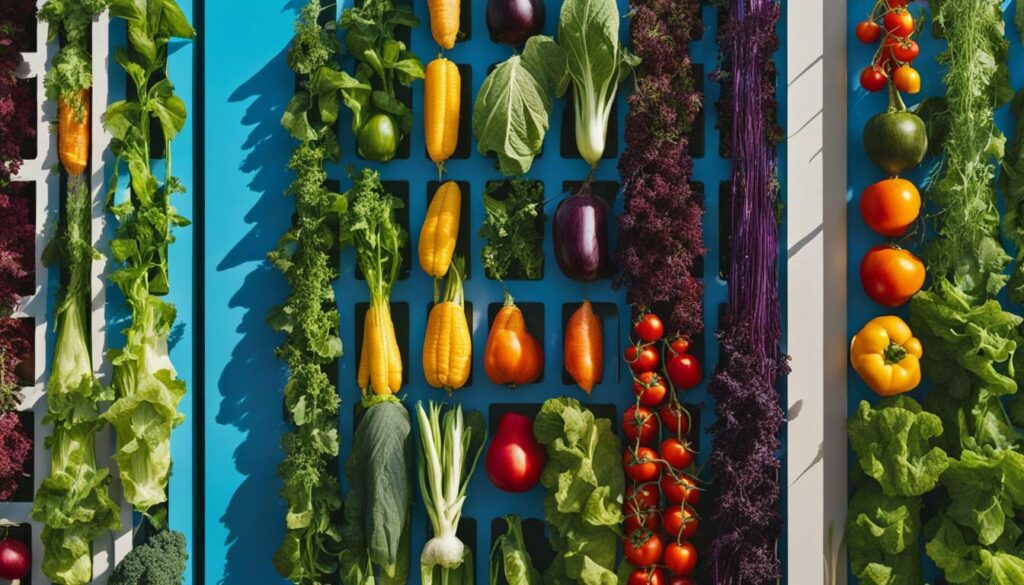
Image: Selecting the Right Plants for Your Vertical Veggie Garden
Building a Sturdy Vertical Support Structure
Learn the essential steps for building a robust vertical support structure to ensure the stability and longevity of your vertical veggie garden.
When constructing a vertical support structure for your garden, it is crucial to consider the strength and durability of the materials used. The structure should be able to withstand the weight of the plants, as well as any external factors such as wind or heavy rain. Additionally, it should provide adequate support for the vines or climbers.
One popular option for vertical support is a trellis system. Trellises can be made from various materials such as wood, metal, or PVC pipes. They are versatile and can be customized to fit the available space and the specific needs of the plants. To ensure stability, it is important to firmly anchor the trellis into the ground or attach it securely to a wall or fence.
Another option is using a wire grid or mesh. This allows for flexibility in terms of the size and shape of the support structure. The wire grid can be attached to a wall or freestanding frame, providing a sturdy surface for plants to climb on. It is important to choose a wire size that can support the weight of the plants and ensure the mesh is tightly secured to prevent sagging.
Table: Pros and Cons of Different Support Structures
| Support Structure | Pros | Cons |
|---|---|---|
| Trellis | Customizable, visually appealing | May require regular maintenance |
| Wire Grid | Flexible, sturdy | May need additional support depending on plant weight |
Regardless of the support structure chosen, it is important to regularly inspect and maintain it throughout the growing season. Make sure to check for any signs of damage or weakness, such as loose screws or sagging wires, and promptly address them to prevent accidents and ensure the longevity of your vertical veggie garden.
By building a sturdy vertical support structure, you can create a safe and reliable foundation for your vertical veggie garden. This will not only maximize your use of space but also provide a visually appealing and productive garden that will thrive for seasons to come.
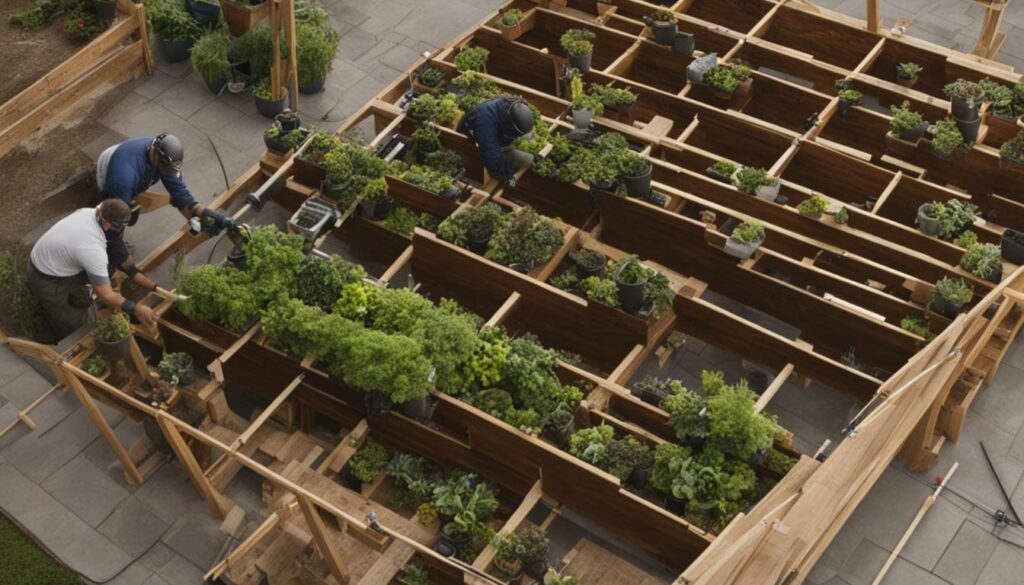
Optimizing Soil and Nutrients for Vertical Gardening
Achieve optimal growth and healthy plants by understanding how to optimize your soil and provide essential nutrients for your vertical veggie garden. Vertical gardening presents unique challenges when it comes to soil quality and nutrient management. With proper care and attention, you can create a thriving garden that yields abundant vegetables.
One important factor to consider is the type of soil you use in your vertical garden. A well-draining soil mix is essential to prevent root rot and waterlogging, which can be detrimental to your plants’ health. A mix of organic compost, peat moss, and perlite is often recommended for vertical gardening. This combination provides adequate drainage while retaining moisture and nutrients.
Additionally, regular fertilization is crucial to ensure your plants receive the nutrients they need to thrive. Slow-release organic fertilizers, such as compost or worm castings, are beneficial for vertical gardens. These fertilizers release nutrients gradually, providing a steady supply for your plants throughout their growth cycle.
Essential Nutrients for Vertical Gardens
Vertical gardens require the same essential nutrients as traditional gardens, but the limited space and vertical orientation can affect nutrient availability. Here are the key nutrients to focus on:
| Nutrient | Function | Sources |
|---|---|---|
| Nitrogen | Promotes leaf and stem growth | Compost, manure, fish emulsion |
| Phosphorus | Stimulates root development and flowering | Bone meal, rock phosphate |
| Potassium | Aids in overall plant health and disease resistance | Wood ash, kelp meal |
| Calcium | Strengthens cell walls and prevents nutrient deficiencies | Eggshells, gypsum |
Regularly monitoring your plants for nutrient deficiencies is important. Yellowing leaves, stunted growth, and poor fruit development can indicate a lack of specific nutrients. Adjust your fertilization routine accordingly to address any deficiencies.
By optimizing your soil and providing the essential nutrients your plants need, you can create a successful vertical veggie garden that thrives in your urban space. Remember to regularly monitor your plants, provide proper care, and make adjustments as needed to ensure the best possible growing conditions.
Watering and Irrigation Systems for Vertical Veggie Gardens
Ensure your vertical veggie garden receives adequate moisture with the right watering and irrigation systems tailored to its specific needs. Proper watering is essential for the health and productivity of your plants, especially in a vertical garden where the water may not reach all areas as efficiently as in traditional gardens.
Drip Irrigation
A popular and efficient method for watering vertical veggie gardens is through drip irrigation systems. This system delivers water directly to the roots of the plants, minimizing water wastage and reducing the risk of overwatering.
By connecting a series of drip emitters to a main water supply line and positioning them strategically along the vertical structure, you can ensure each plant receives a consistent and controlled amount of water. Drip irrigation also helps to minimize weed growth and prevent water-related diseases by keeping the foliage dry.
Self-Watering Containers
Another option for vertical veggie gardens is the use of self-watering containers. These containers have built-in reservoirs or water wicking systems that provide a constant supply of moisture to the plants. This eliminates the need for frequent manual watering and reduces the risk of under or overwatering.
Self-watering containers are particularly suitable for smaller vertical gardens or for busy individuals who may not have the time to water their plants regularly. They offer a convenient and efficient solution, ensuring your plants have a continuous water supply for optimal growth.
Efficient Watering Techniques
In addition to specific irrigation systems, implementing efficient watering techniques can further enhance the health and productivity of your vertical veggie garden. Some key tips include:
- Watering in the early morning or late afternoon to minimize evaporation and allow the plants to absorb moisture before the heat of the day.
- Watering the base of the plants rather than spraying the foliage to reduce the risk of fungal diseases.
- Using mulch around the plants to retain moisture and prevent weed growth.
- Monitoring the soil moisture levels regularly and adjusting the watering frequency accordingly.
By implementing the appropriate watering and irrigation systems in your vertical veggie garden, you can ensure that your plants receive consistent moisture levels, leading to healthier, more productive crops.
| Watering and Irrigation Systems for Vertical Veggie Gardens | Advantages |
|---|---|
| Drip Irrigation | – Delivers water directly to the roots – Minimizes water wastage and overwatering – Reduces weed growth and water-related diseases |
| Self-Watering Containers | – Provides a constant supply of moisture – Requires less frequent manual watering – Suitable for smaller vertical gardens or busy individuals |
| Efficient Watering Techniques | – Watering in the early morning or late afternoon – Watering the base of the plants – Using mulch and monitoring soil moisture levels |
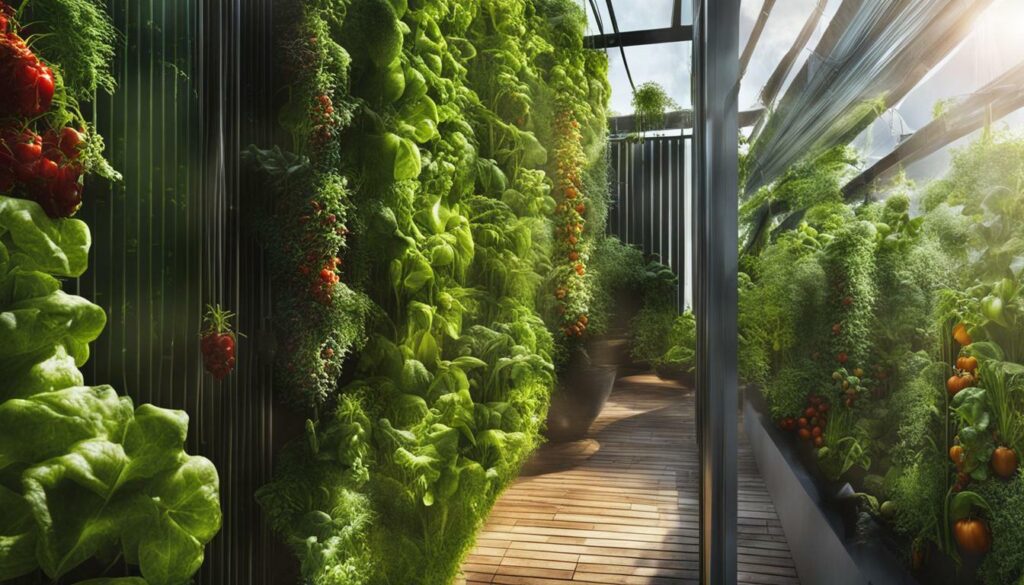
Pests and Disease Prevention in Vertical Gardening
Protect your vertical veggie garden from pests and diseases with effective prevention strategies and natural solutions. By understanding the common pests and diseases that can affect your garden, you can take proactive measures to keep your plants healthy and thriving. Here are some tips to help you prevent and manage pests and diseases in your vertical veggie garden.
Identifying and Preventing Common Pests
One of the main challenges in vertical gardening is controlling pests that can damage your plants. Aphids, spider mites, and whiteflies are among the most common pests that can infest your vertical garden. To prevent an infestation, regularly inspect your plants for signs of pests such as wilted leaves, yellowing, or sticky residue. If you detect any pests, take immediate action.
One effective method of preventing pests is to introduce beneficial insects such as ladybugs and lacewings, which feed on common garden pests. You can also use organic pest control methods like neem oil or insecticidal soap to deter pests. Additionally, practicing good garden hygiene by removing dead leaves and weeds can help minimize pest populations.
Managing Diseases in Vertical Gardening
Diseases can also pose a threat to your vertical veggie garden. Fungal diseases like powdery mildew and bacterial infections can weaken and eventually kill your plants. To prevent diseases, it’s important to practice proper sanitation and plant care.
Start by giving your plants adequate spacing to ensure good airflow, as crowded plants are more prone to disease. Water your plants at the base to avoid wetting their foliage, as excess moisture can promote the growth of fungi. Regularly inspect your plants for any signs of disease, such as unusual spots or discoloration, and promptly remove and dispose of any infected plants or leaves.
To further protect your vertical veggie garden, consider using disease-resistant plant varieties whenever possible. These varieties are bred to be more resistant to specific diseases, giving you a better chance of success in your vertical gardening endeavors.
| Common Pests | Prevention Strategies |
|---|---|
| Aphids | – Introduce beneficial insects – Use insecticidal soap or neem oil – Remove infested plants |
| Spider Mites | – Regularly inspect plants for mites – Increase humidity to deter mites – Use organic miticides |
| Whiteflies | – Use yellow sticky traps as a monitoring tool – Introduce natural predators like predatory wasps – Apply insecticidal soap or neem oil |
By implementing these preventive measures and staying vigilant in your care, you can keep pests and diseases at bay in your vertical veggie garden. Remember, regular monitoring and quick action are key to maintaining a healthy and thriving garden.
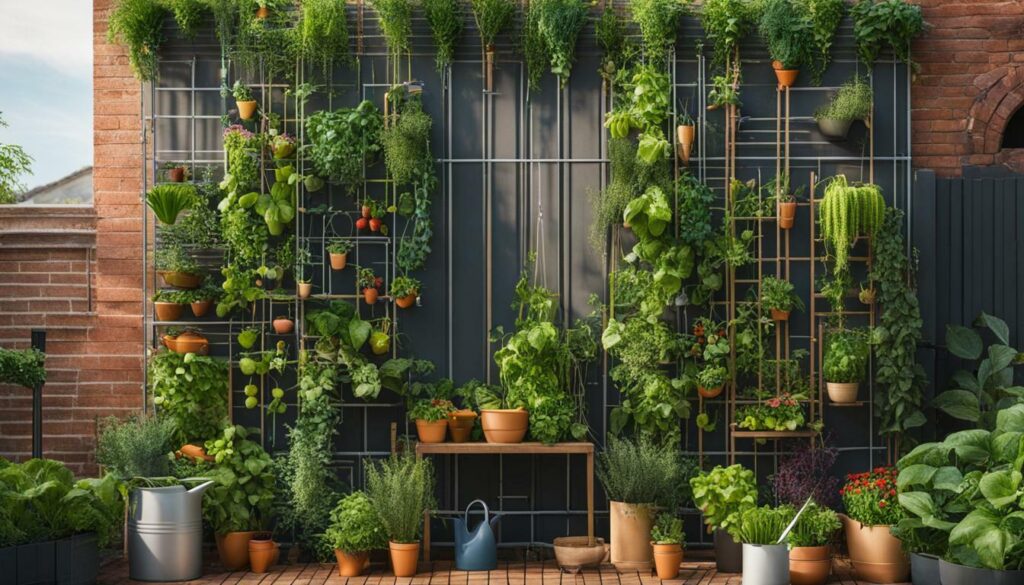
Harvesting and Maintaining Your Vertical Veggie Garden
Discover the art of harvesting and maintaining your vertical veggie garden to ensure a bountiful harvest and continued success. With proper techniques and regular care, you can enjoy the rewards of your hard work while keeping your garden thriving.
When it comes to harvesting, timing is crucial. Different vegetables have varying maturity periods, so it’s important to monitor their growth and pick them at the right time. For example, leafy greens like lettuce and spinach are best harvested when the leaves are young and tender. On the other hand, root vegetables like carrots and radishes should be harvested when their roots have reached a desirable size.
Regular maintenance is essential to keep your vertical veggie garden healthy. Pruning is an important task that helps control the size of your plants and encourages new growth. Removing any dead or damaged leaves, stems, or fruits helps prevent the spread of diseases and pests. Remember to sanitize your pruning tools between plants to avoid cross-contamination.
Pruning Tips
- Remove any yellowing or brown leaves to maintain plant health.
- Pinch off the tips of vining plants to promote lateral growth.
- Trim back overly long stems to prevent them from overshadowing other plants.
Regularly inspecting your vertical veggie garden for pests and diseases is another crucial aspect of maintenance. Implementing preventative measures such as companion planting, proper spacing, and good airflow can help minimize the risk of infestations. However, if you do encounter pests or diseases, it’s important to identify them early and take appropriate action. Natural remedies like neem oil or insecticidal soap can be effective in controlling common pests, while organic fungicides can help combat fungal diseases.
To ensure your vertical veggie garden continues to thrive, it’s important to monitor and adjust the watering and fertilization as needed. Check the moisture level of the soil regularly and water your plants when necessary. Installing a drip irrigation system can help ensure consistent watering and prevent over or under-watering. Additionally, regularly fertilize your plants with a balanced organic fertilizer to provide them with essential nutrients for healthy growth.
| Common Pests | Prevention | Natural Remedies |
|---|---|---|
| Aphids | Planting companion flowers like marigolds or using reflective mulch | Neem oil spray or insecticidal soap |
| Whiteflies | Introducing beneficial insects like ladybugs or using yellow sticky traps | Neem oil spray or insecticidal soap |
| Powdery Mildew | Spacing plants adequately for good air circulation | Organic fungicides like sulfur or potassium bicarbonate |
By following these tips and techniques, you can ensure a successful harvest and maintain a thriving vertical veggie garden. Remember to adjust your practices based on the specific needs of your plants and monitor their progress regularly. With dedication and proper care, you’ll be rewarded with fresh and nutritious produce right at your fingertips.
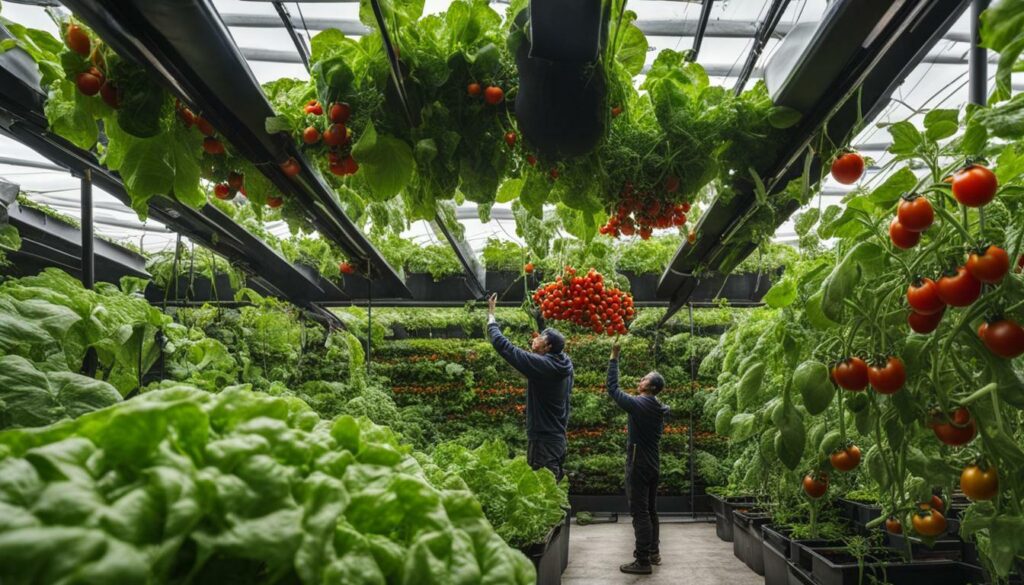
How Can I Use Vertical Gardening to Grow Vegetables in Limited Space?
If you’re short on space, try vertical vegetable garden tips. Using upright structures like trellises, hanging planters, or stacked containers can help maximize space. Choose compact vegetable varieties, use lightweight potting soil, and ensure adequate sunlight for a successful vertical garden.
Conclusion
By following our comprehensive guide, you can transform your urban space into a productive and sustainable vertical veggie garden, maximizing yield and enjoying the numerous benefits it brings. Vertical gardening offers a practical solution for those with limited space, allowing you to grow a wide range of vegetables, herbs, and even fruits in a vertical arrangement.
With careful plant selection, a sturdy support structure, and optimized soil and nutrient management, you can create an efficient and thriving vertical veggie garden. The benefits of this innovative gardening method are plentiful – saving space, maximizing yield, and optimizing sunlight exposure.
By implementing proper watering and irrigation systems, you can ensure that your vertical veggie garden receives the right amount of water without wasting resources. Additionally, understanding common pests and diseases in vertical gardening will help you prevent and manage potential issues, ensuring the health and vitality of your plants.
Regular maintenance practices such as pruning, fertilizing, and monitoring for any signs of trouble will keep your vertical veggie garden in top shape. Harvesting your crops at the right time will maximize their flavor and nutritional value, giving you the satisfaction of enjoying homegrown produce.
Create your own vertical veggie garden today and reap the rewards of fresh, flavorful, and sustainable food right from your urban space. With our comprehensive guide as your ally, you’ll be well-equipped to embark on this exciting journey of vertical gardening.
FAQ
Q: Can I create a vertical veggie garden in a small urban space?
A: Yes, one of the main advantages of a vertical veggie garden is that it allows you to grow vegetables upward, saving space in small urban areas.
Q: What are the benefits of having a vertical veggie garden?
A: Some of the benefits of a vertical veggie garden include maximizing yield, saving space, and optimizing sunlight exposure for your plants.
Q: How do I choose the right plants for my vertical veggie garden?
A: When selecting plants for your vertical veggie garden, consider factors such as their sunlight requirements, space constraints, and growing conditions to ensure their success.
Q: How can I build a sturdy vertical support structure for my veggie garden?
A: To construct a sturdy vertical support structure for your veggie garden, consider the materials you’ll be using, design considerations, and installation tips to ensure stability and durability.
Q: What should I know about optimizing soil and nutrients for vertical gardening?
A: Optimizing soil quality and nutrient management is crucial in vertical gardening. Selecting the right soil, composting techniques, and proper fertilization methods are key to maintaining healthy plants.
Q: What are some watering and irrigation systems suitable for vertical veggie gardens?
A: There are various watering and irrigation systems you can implement in your vertical veggie garden, such as drip irrigation, self-watering containers, and efficient watering techniques to ensure proper hydration for your plants.
Q: How can I prevent pests and diseases in my vertical veggie garden?
A: Vertical veggie gardens are susceptible to common pests and diseases. To prevent them, you can employ preventative measures and natural remedies to maintain the health and vitality of your garden.
Q: What should I know about harvesting and maintaining my vertical veggie garden?
A: Knowing when and how to harvest crops from your vertical veggie garden is important for maximizing yield. Additionally, proper maintenance practices like pruning, fertilizing, and monitoring for potential issues are essential for the longevity of your garden.
Q: What will the conclusion of the article cover?
A: The conclusion will summarize the key points discussed throughout the article and emphasize the benefits of creating a vertical veggie garden in an urban space.

